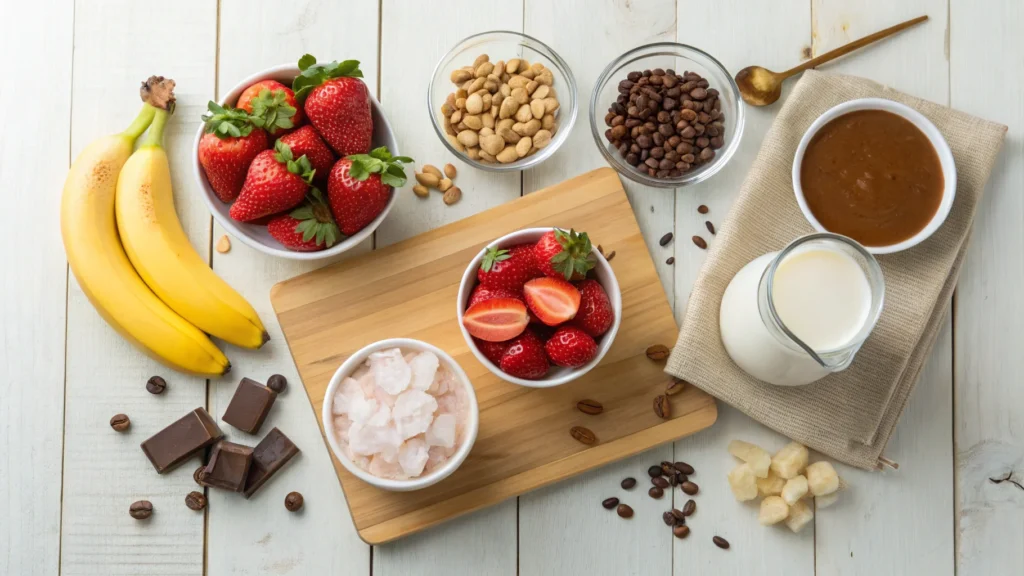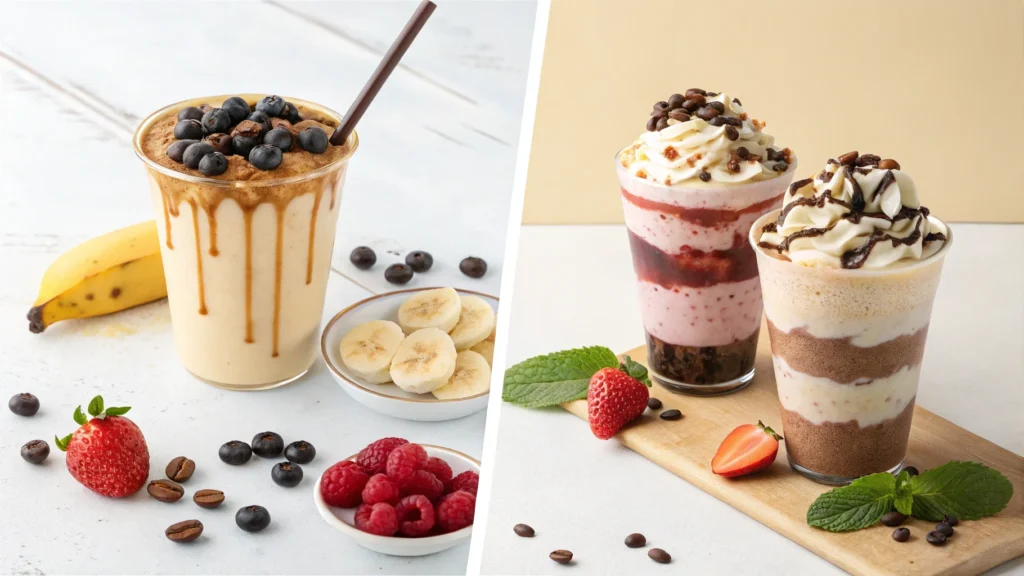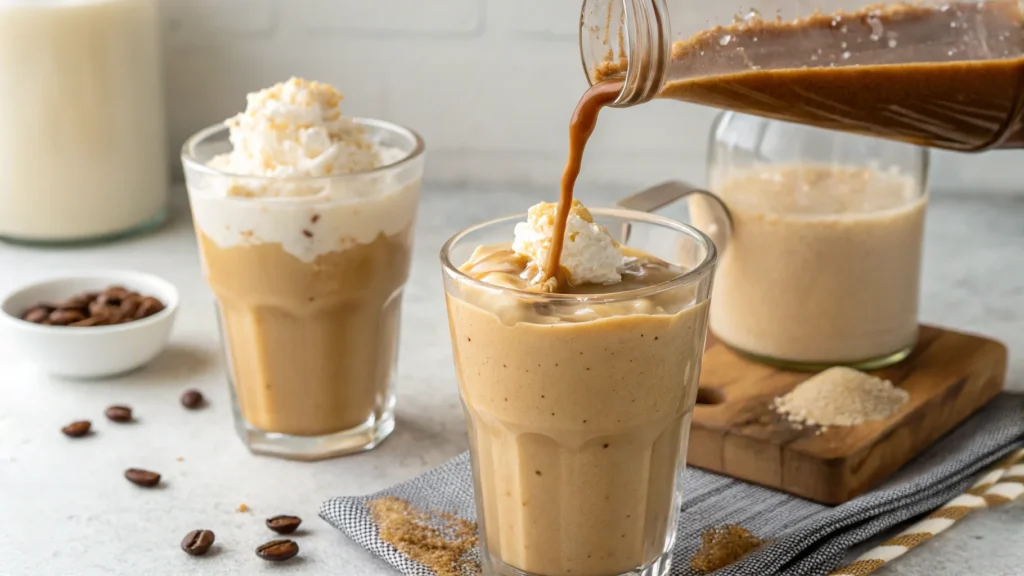Smoothies and frappes are two of the most popular cold beverages, loved for their refreshing taste and versatility. But have you ever wondered, what is the difference between smoothie and frappe? While they might look similar at first glance, their ingredients, texture, preparation methods, and even their nutritional value set them apart.
A smoothie is typically a thick, fruit-based drink blended with yogurt, milk, or juice, making it a nutritious option for breakfast or a post-workout boost. A frappe, on the other hand, is an ice-blended drink, often made with coffee, milk, and sweeteners, delivering a rich and creamy indulgence.
In this article, we’ll break down everything you need to know about smoothies vs. frappes—from their composition and preparation to their nutritional value and cultural significance. By the end, you’ll know exactly which one suits your taste and lifestyle best!
Table of contents
Introduction to Smoothies and Frappes
What is a Smoothie?
A smoothie is a thick, blended drink made primarily from fruits, vegetables, yogurt, milk, or plant-based alternatives. Unlike juices, smoothies retain all the fiber from fruits and vegetables, making them more filling and nutritious.
Common ingredients in smoothies include:
- Fresh or frozen fruits (bananas, berries, mangoes)
- Dairy or plant-based milk (almond milk, soy milk)
- Yogurt for creaminess
- Nuts, seeds, or protein powder for added nutrition
Smoothies are widely considered a healthy choice, often consumed as a meal replacement, pre- or post-workout drink, or a refreshing snack.
What is a Frappe?
A frappe is an ice-blended beverage, typically made with coffee, milk, ice, and sweeteners. It has a slushy, frothy consistency due to the blending of crushed ice with liquid ingredients. While frappes are commonly associated with coffee-based drinks, they can also be made without caffeine, using flavors like vanilla, caramel, or chocolate.
Key elements of a frappe include:
- Crushed ice for texture
- Sweeteners (syrup, honey, or sugar)
- Milk or cream for smoothness
- Optional coffee or chocolate flavors
Unlike smoothies, frappes are more of a dessert-like treat rather than a health-focused drink.
Why People Confuse Smoothies and Frappes
Because both drinks are served cold, blended, and customizable, they often get mixed up. However, the key difference lies in texture and ingredients—smoothies are fruit-based and thick, while frappes are icy and often coffee-based.
So, next time you’re ordering a cold drink, you’ll know exactly whether to pick a smoothie for a nutrient boost or a frappe for a sweet and creamy indulgence!

Ingredients and Composition
When comparing these two drinks, one of the biggest factors that sets them apart is their ingredients and composition. So, what is the difference between smoothie and frappe when it comes to what goes inside the blender? Let’s break it down.
What Ingredients Are Used in a Smoothie?
A smoothie is known for its thick, creamy consistency, which comes from blending natural, wholesome ingredients. These include:
- Fruits and Vegetables – Bananas, berries, mangoes, spinach, kale, or avocado for flavor and nutrients.
- Liquids – Milk, almond milk, yogurt, coconut water, or fruit juice help achieve a smooth texture.
- Add-Ins – Chia seeds, flaxseeds, honey, oats, or protein powder for an extra nutritional boost.
Smoothies are typically made without ice since they rely on frozen fruits or thickening agents like yogurt. This gives them a rich, velvety texture.
What Ingredients Are Used in a Frappe?
A frappe, on the other hand, is an ice-blended beverage that often has a lighter, frothy feel. Common ingredients include:
- Crushed Ice – The key to the frappe’s signature slushy texture.
- Liquid Base – Milk, cream, or non-dairy alternatives for creaminess.
- Sweeteners – Sugar, flavored syrups, or condensed milk for added sweetness.
- Coffee or Chocolate – Traditional frappes often include espresso or chocolate powder for flavor.
Since frappes contain a high amount of ice, they have a much colder, more refreshing feel compared to smoothies.
Key Ingredient Differences
So, what is the difference between smoothie and frappe when it comes to composition? Smoothies are fruit-based and naturally thick, while frappes rely on ice and dairy for a frothy, blended texture.
Preparation Methods
Beyond ingredients, the way these drinks are made also sets them apart. While both require a blender, their blending techniques and preparation methods create very different results.
How Are Smoothies Made?
Smoothies are made using a high-speed blender that purees all ingredients into a creamy, uniform drink. Here’s how:
- Add Liquids First – This helps the blender process everything smoothly.
- Blend Fruits and Veggies – Fresh or frozen, they create the drink’s body.
- Include Add-Ins – Protein powder, nuts, or seeds can be added for extra nutrition.
- Blend Until Smooth – The goal is a thick but drinkable consistency.
Smoothies don’t usually need ice, as frozen fruits naturally chill and thicken the drink. This results in a dense, rich texture that retains all fiber and nutrients.
How Are Frappes Made?
Frappes, in contrast, use crushed ice and high-speed blending to achieve a light, airy consistency. The process typically includes:
- Adding Ice and Liquid Base – Milk, coffee, or flavored syrups form the foundation.
- Blending Until Frothy – The high-speed motion breaks down the ice into tiny pieces, giving frappes their signature texture.
- Sweetening to Taste – Many frappes include sugar, syrups, or whipped cream for extra indulgence.
Unlike smoothies, frappes require significant blending time to get that foamy, frothy top layer.
Smooth Blending vs. Ice Blending
So, what is the difference between smoothie and frappe in terms of preparation? Smoothies focus on blending fruits into a thick, fiber-rich drink, while frappes are all about blending ice and dairy for a slushy, creamy treat.
Texture and Consistency Differences
One of the easiest ways to tell a smoothie from a frappe is by looking at their texture and consistency. But what is the difference between smoothie and frappe in terms of how they feel when you drink them?
Why Are Smoothies Thicker?
Smoothies have a thick, creamy consistency, mainly because they contain:
- Whole fruits and vegetables, which add natural fiber and thickness.
- Yogurt, milk, or nut-based alternatives that create a velvety texture.
- Frozen fruits instead of ice, preventing a watery feel.
Since smoothies are pureed rather than blended with ice, they have a dense, rich mouthfeel, making them more filling.
Why Are Frappes More Icy?
A frappe, in contrast, is much lighter and frothier due to:
- The large amount of crushed ice, giving it a slushy texture.
- The fast blending process, which aerates the mixture, creating a foamy top.
- The lack of thickening ingredients, making it more fluid.
Because frappes rely on ice, they melt faster than smoothies, which means they need to be consumed quickly for the best taste.
For more delicious smoothie ideas, check out this refreshing berries ginger turmeric smoothie recipe.

Nutritional Differences
Now, let’s compare the nutritional value of these two drinks. What is the difference between smoothie and frappe when it comes to health benefits?
Are Smoothies Healthier Than Frappes?
In general, smoothies are the healthier choice because they:
– Use fresh, whole ingredients packed with fiber, vitamins, and antioxidants.
– Can be customized with nutrient-dense add-ins like chia seeds, flaxseeds, and protein powder.
– Contain natural sugars from fruits rather than refined sugar.
However, not all smoothies are created equal. Store-bought or sugar-loaded smoothies can be high in calories. To keep them healthy, opt for homemade versions with fresh ingredients.
Caloric and Nutritional Breakdown
Frappes, on the other hand, are often higher in sugar and fat, especially when made with:
– Syrups and whipped cream, adding extra calories.
– Condensed milk or heavy cream, which increases fat content.
– Sweetened coffee bases, which contribute to sugar overload.
A typical fruit smoothie may have around 200-300 calories per serving, while a frappe can easily exceed 400-500 calories, depending on the toppings.
Smoothie or Frappe: Which One Should You Choose?
If you’re looking for a nutritious, energy-boosting drink, a smoothie is the way to go. But if you’re craving a sweet, icy indulgence, a frappe is a satisfying treat.
For a deeper dive into frappes vs. smoothies, check out this Frappe, Shake, or Smoothie Guide.
Popular Variations and Customization
Both smoothies and frappes come in a variety of flavors and styles, making them highly customizable. But what is the difference between smoothie and frappe when it comes to variations? Let’s explore some of the most popular options.
Types of Smoothies
Smoothies can be tailored to different health goals and taste preferences. Some popular types include:
- Fruit-Based Smoothies – Made with fresh or frozen fruits like bananas, strawberries, mangoes, and blueberries.
- Green Smoothies – Blended with leafy greens like spinach or kale for added nutrients.
- Protein Smoothies – Contain protein powder, yogurt, or nut butter to support muscle recovery.
- Breakfast Smoothies – Often include oats, peanut butter, or flaxseeds for sustained energy.
Smoothies are easily modified—you can swap ingredients, adjust sweetness, or add superfoods like chia seeds or turmeric for extra benefits.
Types of Frappes
Frappes are more indulgent and often coffee-based, but they also come in different styles:
- Classic Coffee Frappe – A blend of coffee, ice, and milk, sometimes topped with whipped cream.
- Chocolate or Caramel Frappe – Popular dessert-like options that include sweet syrups.
- Fruit-Based Frappes – Made with fruit syrups or puree instead of coffee.
- Dairy-Free Frappes – Use almond, oat, or coconut milk as alternatives.
Unlike smoothies, frappes tend to be sweeter and more dessert-like, often topped with whipped cream, caramel drizzle, or chocolate chips for added flavor.
Best Occasions to Enjoy Each Drink
Since smoothies and frappes offer different textures and nutritional profiles, they are best suited for different occasions. But what is the difference between smoothie and frappe in terms of when to drink them?
When to Drink a Smoothie?
A smoothie is a great daily beverage that can be enjoyed:
- For Breakfast – Packed with fiber and protein, it provides sustained energy.
- Post-Workout – Helps with muscle recovery when made with protein-rich ingredients.
- As a Meal Replacement – A filling option when blended with oats, nut butter, and yogurt.
- As a Refreshing Snack – Hydrating and nutritious, especially when made with coconut water or citrus fruits.
Since smoothies are nutrient-dense and naturally sweet, they are a healthy choice for anytime energy.
When to Drink a Frappe?
Frappes, on the other hand, are best enjoyed as a treat or occasional indulgence:
- As a Midday Pick-Me-Up – Coffee frappes provide a caffeine boost.
- During Hot Weather – The icy texture makes them extra refreshing.
- As a Dessert Alternative – A sweet and creamy option for satisfying cravings.
- At Coffee Shops or Cafés – A go-to specialty drink when socializing.
Unlike smoothies, frappes aren’t as filling or nutrient-rich, so they are more of a fun, sweet beverage rather than a meal replacement.
Cultural and Regional Popularity
Both smoothies and frappes are enjoyed worldwide, but their popularity and cultural significance vary depending on the region. So, what is the difference between smoothie and frappe in terms of where they are most commonly consumed?
Where Are Smoothies More Popular?
Smoothies are a staple in health-conscious cultures, particularly in:
- The United States – A favorite breakfast or post-workout drink, with smoothie bars in nearly every city.
- Brazil & Tropical Regions – Fresh fruit smoothies are common, often featuring mango, guava, and coconut water.
- Asia & The Middle East – Variations like avocado smoothies (yogurt-based drinks) are widely consumed.
- Europe – Growing in popularity, especially in wellness communities.
Smoothies have gained global recognition as a nutritious and convenient meal option, often associated with fitness, wellness, and plant-based diets.
Where Are Frappes More Popular?
Frappes, especially coffee-based ones, thrive in café cultures worldwide, including:
- Greece – The birthplace of the traditional coffee frappe, made with instant coffee and ice.
- United States – Coffeehouse chains like Starbucks popularized frappes as an indulgent iced coffee treat.
- France & Italy – Home to café culture, where frappes are a go-to iced coffee drink.
- Southeast Asia – Often made with condensed milk for an extra sweet and creamy texture.
Unlike smoothies, frappes are more associated with coffee culture and are often enjoyed in social settings rather than as a health-focused beverage.

Conclusion and Final Comparison
After exploring every aspect of these two beverages, what is the difference between smoothie and frappe in the simplest terms?
Which One Should You Choose?
The choice between a smoothie and a frappe depends on your taste, health goals, and lifestyle:
– Choose a smoothie if you want a nutrient-dense, filling, and naturally sweetened drink.
– Go for a frappe if you’re craving a sweet, icy, and indulgent beverage, often with coffee.
Summary of Key Differences
To wrap things up, here’s a quick recap:
| Feature | Smoothie | Frappe |
|---|---|---|
| Texture | Thick, creamy | Icy, frothy |
| Ingredients | Fruits, yogurt, milk | Ice, milk, coffee (optional) |
| Healthiness | Generally healthier | Higher in sugar |
| Best For | Breakfast, meal replacement | Refreshing treat, caffeine boost |
| Cultural Use | Wellness, fitness communities | Café and coffee culture |
In the end, both drinks have their own appeal. Whether you prefer a health-boosting smoothie or an ice-cold frappe, now you can make the perfect choice based on your needs! 😊

